Properties of Carbon Dioxide Vapour
| ✅ Paper Type: Free Essay | ✅ Subject: Physics |
| ✅ Wordcount: 1214 words | ✅ Published: 11 Sep 2017 |
- Greenhouse gases in global warming
The greenhouse effect is necessary for Earth to regulate its temperature. Water vapour (H2O), carbon dioxide (CO2) methane (CH4), nitrous dioxide (N2O) and ozone (O3) are some of the gases that contribute to it. These gases are molecules that are made up of more than 2 component atoms. They vibrate upon absorbing thermal infrared radiation and then re-radiate excess energy in all directions. As the Earth’s surface is now heated by both the emitted radiation and sunlight, temperature increases and thus causing the greenhouse effect.
|
Common Greenhouse Gases |
Greenhouse Effect |
Greenhouse Gas Atmospheric |
Absorption Region on Electromagnetic |
|
Water vapour (H2O) |
95 |
7600 ppmv |
0.8 -10 |
|
Carbon dioxide (CO2) |
3.618 |
401 ppmv |
2.6, 4, >13 |
|
Methane (CH4) |
0.360 |
1780 ppbv |
3.5 – 8 |
|
Nitrous oxide (N2O) |
0.95 |
320 ppbv |
5, 8 |
|
Ozone (O3) |
0.072 |
28 ppbv |
0.1-0.3, 9 |
As shown in the table above, water vapour (H2O) contributes the most to the greenhouse effect When temperature increases, air humidity increases as well which is positive water vapour feedback. This allows a higher concentration of CO2 in the atmosphere thus further enhancing the warming effect of other greenhouse gases.
When temperature increases, air humidity increases as well which is positive water vapour feedback. This allows a higher concentration of CO2 in the atmosphere thus further enhancing the warming effect of other greenhouse gases.
Carbon dioxide (CO2) contributes quite a fair amount to the greenhouse effect. Thanks to human activities like deforestation, land use changes and burning of fossil fuel, the atmospheric CO2 concentration has increased by about 120ppm since the Industrial Revolution began, which is more than a third.
With an absorption region of 3.5-8 microns on the electromagnetic spectrum, methane (CH4) is way more active than carbon dioxide as a greenhouse gas. Its greenhouse effect contribution is small due to its low atmospheric concentration. Being in a similar absorption spectrum as H2Oalso masks methane’s contribution as work might have been done by H2O already.
Nitrous oxide(N2O) is typically formed through production of nitric acid, combustion of fossil fuel, agriculture sector and burning of  . Even though N2O has a low atmospheric concentration, it still contributes a decent amount to the greenhouse effect. This is because it is up to about 300 times stronger as a greenhouse gas than CO2.
. Even though N2O has a low atmospheric concentration, it still contributes a decent amount to the greenhouse effect. This is because it is up to about 300 times stronger as a greenhouse gas than CO2.
As ozone (O3) has various concentration at different parts of the atmosphere and has a short lifespan, it is hard to gauge the contribution of the troposphere ozone layer. Ozone generally does not affect much of the greenhouse effect anyway.
- Lewis Structures of CO and CO2



- Carbon Monoxide
a) Rotational Constant, B
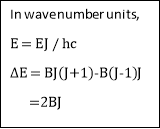


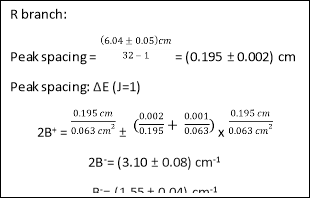

Taking largest B = 2.04  and smallest B = 1.51
and smallest B = 1.51 ,
,

b) Bond Length, b
Reduced mass of carbon monoxide:







Since literature value for bond length, b = 113pm lies within the range of  , and the uncertainty of calculated bond length value is insignificant compared to the calculated value itself, the calculated value can be said to be quite accurate.
, and the uncertainty of calculated bond length value is insignificant compared to the calculated value itself, the calculated value can be said to be quite accurate.
c) Vibrational Wavenumber,
Distance of first through in P branch from 2050 cm-1= (5.45 ± 0.05) cm
Distance of first through in R branch from 2050 cm-1= (5.72 ± 0.05) cm


Taking smallest  = 2135
= 2135 and largest
and largest  = 2143
= 2143 ,
,

 d) Force Constant, k
d) Force Constant, k





e) Molar Zero-Point Vibrational Energy, 







Carbon Dioxide
- Rotational Constant,



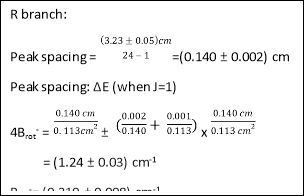

Taking smallest  = 0.302 cm-1 and largest
= 0.302 cm-1 and largest  = 0.46 cm-1,
= 0.46 cm-1,


Since literature value for  = 0.390 lies within the range of
= 0.390 lies within the range of  , and the uncertainty of calculated bond length value is insignificant compared to the calculated value itself, the calculated value can be said to be quite accurate.
, and the uncertainty of calculated bond length value is insignificant compared to the calculated value itself, the calculated value can be said to be quite accurate.
- Vibrational Modes
CO2 is a linear molecule with 3 atoms. Therefore, it has 3 translational modes, 2 rotational modes, and 3N-5 = 4 vibration modes: 1 symmetric stretch, 1 asymmetric stretch and 2 bending modes. The mode at 667 cm-1 is said to be twofold degenerate because the 2 bending motions are essentially the same, just deforming in different coordinate directions.
Exclusion Rule: no modes can be both infrared and Raman active for a molecule with a centre of symmetry. CO2 has a centre of symmetry therefore relevant to the rule.
For infrared spectroscopy, the 2 bending and the asymmetric stretching modes can be observed. This is because these modes induce a dipole change in their motions. For Raman spectroscopy, symmetric bending can be seen. This is because when the O atoms move away from the centre C atom in an equal distance, the electron density cloud changes with the change in size of molecule, thus causing a change in polarizability.
- Bond Length, b & Force Constant, k





Since literature value for  lies within the range of (119.6±12.5)pm, and the uncertainty of calculated bond length value is insignificant compared to the calculated value itself, the calculated value can be said to be quite accurate.
lies within the range of (119.6±12.5)pm, and the uncertainty of calculated bond length value is insignificant compared to the calculated value itself, the calculated value can be said to be quite accurate.
 For symmetric stretch,
For symmetric stretch, 
k CO2 < k CO because the carbon-oxygen triple bond in CO is stiffer than the carbon-oxygen double bond in CO2.
Heat Capacity
- Molar constant-volume heat capacity
For CO2: Translational modes,  :
:  , Vibrational modes,
, Vibrational modes,  :
:  ,
,
Rotational mode,  :
: 
Total internal energy, 
At very high temperatures, the theoretical maximum internal energy =  as all modes are activated at that point.
as all modes are activated at that point.
 Max. constant-volume heat capacity,
Max. constant-volume heat capacity,

However, at low temperatures not all rotational and vibrational modes are active.
Contributions of different modes at low temperatures:
Rotational Modes

Rotational temperature, 
Vibrational Modes
 Vibrational temperature,
Vibrational temperature, 
Symmetric stretch ( ) :
) : 
Bending modes ( ) :
) : 
Asymmetric stretch ( ) :
) : 

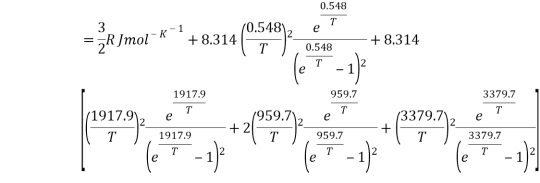
- Graph of
 against T
against T
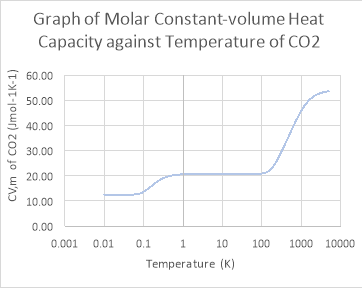
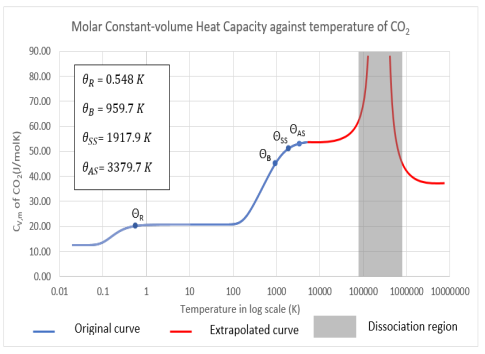
Convert molar constant-volume heat capacity to molar constant-pressure heat capacity with Ideal Gas Law:  , (R = ideal gas constant)
, (R = ideal gas constant)
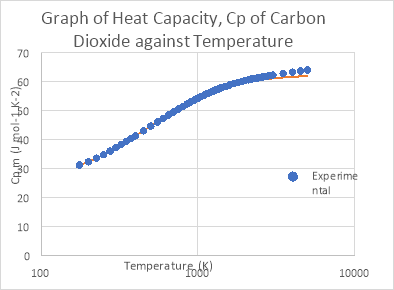
The graph for experimental and calculated data is the same until around T=1600K where the 2 lines diverge with the experimental data to be higher than calculated data. This shows that the Ideal Gas Law only applies to relatively low temperatures.
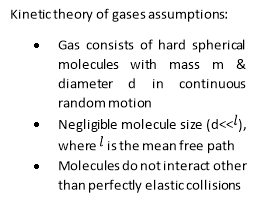 Kinetic Theory of Gases and Liquids
Kinetic Theory of Gases and Liquids
- Mean free path of CO2
Mean free path: average distance travelled by molecules between collisions
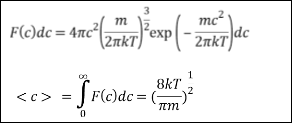


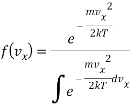

Rate of collision  ,
, : Collision cross-section (area covered by a molecule and within which the presence if the centre of another molecule counts as a collision)
: Collision cross-section (area covered by a molecule and within which the presence if the centre of another molecule counts as a collision)
 Collisions happen at 90o angles on average, mean speed =
Collisions happen at 90o angles on average, mean speed =  ïƒ
ïƒ  [8].
[8].

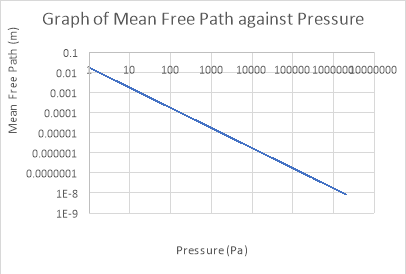
- Viscosity of CO2 vapour
 Newton’s Law of Viscosity:
Newton’s Law of Viscosity: 

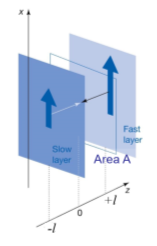 Newton’s 2nd Law: Force = rate of change of momentum
Newton’s 2nd Law: Force = rate of change of momentum
- From plane at 0 from plane
 :
:
mean flow velocity =  ïƒ mean momentum of
ïƒ mean momentum of 
- Roughly1/6th of the molecules move in the +z direction.
- Number of molecules entering 0 from
 per unit time =
per unit time =  ïƒ rate of momentum =
ïƒ rate of momentum = 
- Rate of momentum entering 0 from
 =
=  . By calculating the difference between the two rates, net rate of the momentum transported across the plane at 0,
. By calculating the difference between the two rates, net rate of the momentum transported across the plane at 0,  and by using
and by using  , the viscosity,
, the viscosity,  can be estimated. [8]
can be estimated. [8]
 (mean velocity),
(mean velocity),  (path length)
(path length)

Viscosity is predicted to be proportional to the square root of temperature and independent of density.


Liquefaction in a condenser
 [9]
[9]
Modify the Ideal Gas Law to obtain Van der Waals Equation of State.
to obtain Van der Waals Equation of State.
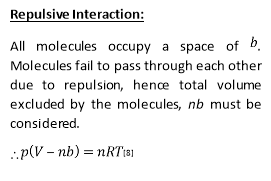



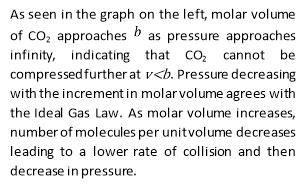

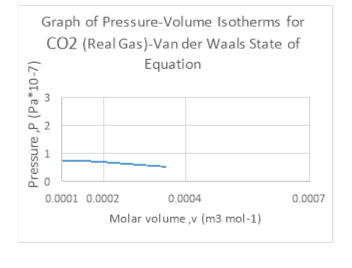
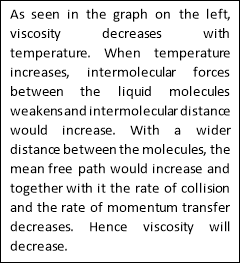
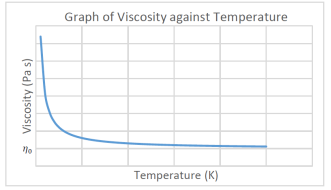
References:
[1] https://climate.nasa.gov/causes/ (accessed 14th March 2017]
[2] Greenhouse Gas Absorption Spectrum (n.d.) available from:http://www.meteor.iastate.edu/gccourse/forcing/spectrum.html (accessed 14th March 2017)
[3] Barrett Bellamy Climate Greenhouse Gas Concentrations (n.d.) available from: http://www.barrettbellamyclimate.com/page22.htm (accessed 15th March 2017)
[4] Monte Hieb (2015) Water Vapor Rules the Greenhouse System. Available from: http://www.geocraft.com/WVFossils/greenhouse_data.html
[5] Project Learn at http://www.ucar.edu/learn at the University Corporation for Atmospheric Research (UCAR) https://www.ucar.edu/learn/1_3_1.htm (accessed 15/3/2017)
[6] Barrett Bellamy Climate Greenhouse Gas Spectra (n.d.) available from: http://www.barrettbellamyclimate.com/page15.htm (accessed 15/3/2017)
[7] NIST Standard Reference Database 101 (September 2015) Listing of experimental data for CO2 (Carbon dioxide) Available from: http://cccbdb.nist.gov/exp2.asp?casno=124389 [Accessed 10 Mar 2016]
[8] Dr Joao Cabral (n.d.) Properties of Matter Lecture Notes. Department of Chemical Engineering, Imperial College London
[9] Steve [2010] The Freezing Point and The Dew Point – Part 2 available from: https://stevengoddard.wordpress.com/2010/09/05/the-freezing-point-and-the-dew%C2%A0point-part-2/
Cite This Work
To export a reference to this article please select a referencing stye below:
Related Services
View allDMCA / Removal Request
If you are the original writer of this essay and no longer wish to have your work published on UKEssays.com then please click the following link to email our support team:
Request essay removal

 (µm)
(µm)


